Today you learn about Commercial Mushroom Cultivation:
Mushroom cultivation is one of the most significant agriculture business in the world.
Mushroom Cultivation History
The first mushroom, ” Auricularia auricula,” was cultivated about 600 A.D. Later, around 800-900A. D. “Flammulina velutipes” were cultivated in China.
In India, commercial mushroom farming started recently, Himachal Pradesh, Punjab, Haryana, Uttar Pradesh, Maharashtra, Tamil Nadu, Karnataka Andhra Pradesh is a major mushroom producing state.
Nutritional Value of Mushrooms
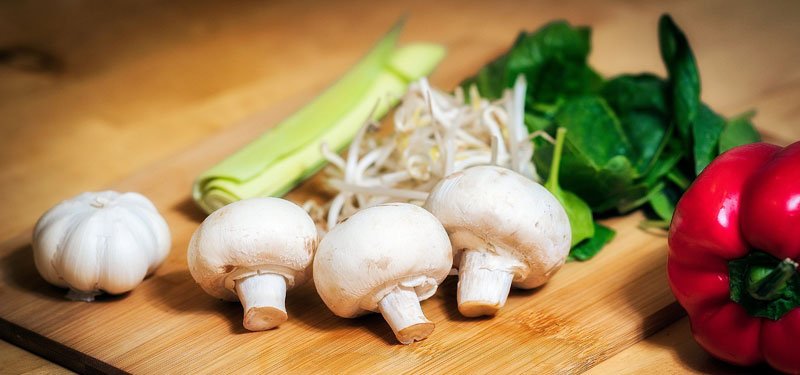
Mushrooms contain more protein than fruits & vegetables and, Mushrooms can also be low in cholesterol.
Apart from their protein content, mushrooms can also be high in certain vitamins like B, C, vitamin D, riboflavin, thiamine nicotinic acid.
Also an excellent source of iron, potassium, and potassium along with folic acid, a component known for improving the blood and avoidance deficiencies.
Mushrooms are recommended as healthy food by the Food and Agricultural Organisation of the United Nations.

Mushroom Cultivation in India
In India, a marginal farmers and small manufacturing units produce Fifty percent of mushrooms, and the remaining mushrooms produce by industrial institutions.
There are two types of mushroom growers in India, and seasonal farmers produce on a small scale.
While commercial mushroom framer who takes production continue entire year in large scale.
Mostly both develop white button mushrooms to your domestic market and export.
The seasonal button mushroom growers are restricted to temperate regions like Himachal Pradesh, Jammu, and Kashmir, hilly areas of Uttar Pradesh, hilly areas in Tamil Nadu, and North Eastern areas where farmers take 2-3 plants of button mushrooms at a year.
Commercial mushroom farming required heavy expenditure on the building infrastructure, purchase of machinery and equipment, raw materials, labor, and energy.
A mushroom grower needs to undergo a practically oriented training program.
In India, there are various government & NGO organizations provide, provide mushroom cultivation training. However, NRCM is a pioneer institute that provides training.
Our Indian government also promotes mushroom cultivation; hence they give subsidies under a different scheme like the national horticulture board, the Ministry of food processing, and APEDA.
Before making to start mushroom farming, decision following Factors have to be Considered to become successful in the commercial mushroom production business :
- The mushroom farm should be closer to the house of the farmer for successful Participation and monitoring purposes.
- Availability of lots of water on the farm
- Easy accessibility to raw materials at competitive prices in the region
- Simple access to labor at more affordable prices.
- Availability of power at competitive prices, as electricity is a significant input in mushroom cultivation.
- The farm should be from industrial pollutants such as chemical fumes,
- There should be a provision for sewage disposal.
- There should be provision for future growth in the farm.
Types of Mushrooms
There are various types of edible mushrooms available globally, but mostly four types of mushrooms are cultivated in India.
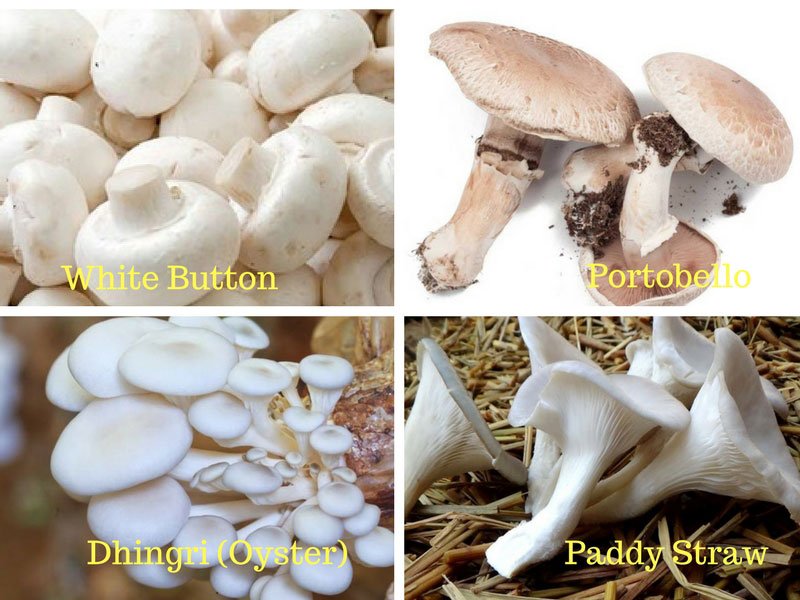
- White Button Mushroom
- Portobello Mushroom
- Dhingri (Oyster) Mushroom
- Paddy Straw Mushroom
Among all the above, White Button mushroom has high demand the most popular hence most farmer select this variety for commercially mushroom farming.
The average price for white button mushrooms is between 50-100 rs per kg. This depends upon market demand. Hotels and metro cities mostly consume white Button mushrooms.
Button mushroom cultivation process

The cultivation of button mushroom “Agaricus bisporus” species is chosen because, Regarding production, it comes a first place in the world.
In India, the favorable season for mushroom cultivation is October to march.
The cultivation Procedure has five main steps.
- Mushroom Spawn
- preparing of compost
- Spawning of mulch
- Casing
- Cropping and harvest administration
Mushroom Spawn:
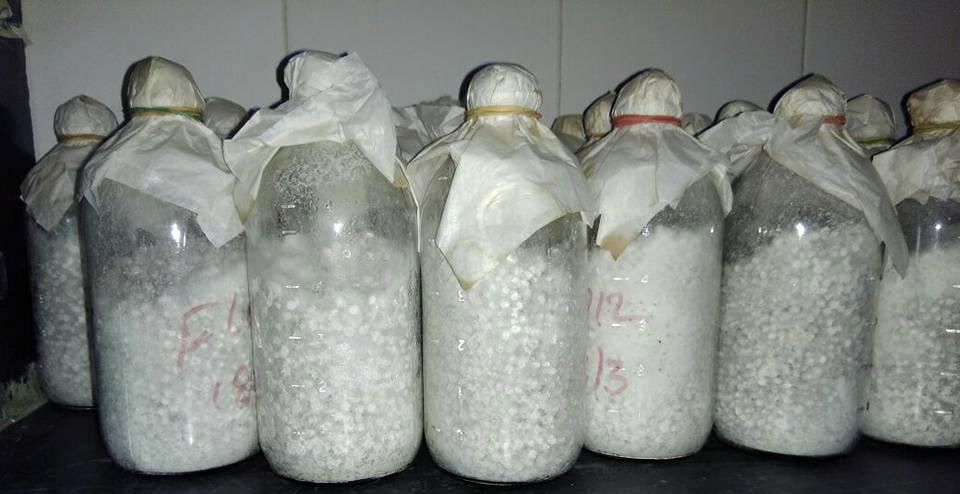
the mushroom growing process starts from Spawn preparation
Spawn is planting material for mushroom cultivation. That is, it is a seed of a mushroom. The mushroom spawn preparation required greater technical skill & investment; mostly, mushroom spawn produces large institutes.
mushroom grower import spawn from the renowned source
here you can find a list of mushroom spawn producer
Good Qualities mushroom spawn has the following qualities
- The spawn should Be rapidly growing in the compost
- Provide early pruning following casing
- high yielding
- It must create a greater grade of mushroom
Preparing of compost

Compost is an artificially prepared growth medium from which mushrooms can derive essential nutrients necessary for growth.
There are two primary methods for compost preparation:
- Longer Method
- Short Method
The short Method takes less time to prepare compost than the longer method but requires more capital and resources. The compost made by the short method is suitable for high-yielding mushroom production.
Longer Method:
This is an outdoor procedure and takes around 28 days in its conclusion with seven turnings.
Materials are required for the longer method is as follows.
| Ingredient | weight |
|---|---|
| Wheat straw | 300 kg |
| Wheat bran | 15 kg |
| calcium ammonium nitrate | 9 kg |
| Urea | 4 kg |
| Muriate of Potash | 3 kg |
| Superphosphate | 3 kg |
| Gypsum | 20 Kg |
Before creating compost, The mixture of wheat straw or paddy straw is placed for 1-2 days (24-48 hours) on the floor and spray water several times a day with a fixed time interval.
Day 0:
In this stage, the above Ingredient except Gypsum is mixed well and makes a 5-feet-wide, 5-foot-high stack. With wooden box help or any other equipment in grow room.
The stack’s length depends on the amount of material, but the height and width should not be more or less than the measurements are written above, and It kept as it is for five days.
Water is spray as per the requirement of lower moisture in the outer layers. This stack’s temperature in about two to three days gets around 65-70 ° C, which is a good sign.
First turnaround (6th day)
On the sixth day, start the first turnaround.
Keep in mind that each part of the stack should be thoroughly mixed during the turning point, and enough air circulates so that humidity gets rid of each piece of compost.
If the compost’s moisture content is reduced, then the water is sprayed as per the requirement. The size and size of the new pile are similar to the first one.
Second turnaround (10th day)
The second turnaround is similar to the first turnaround
Third turnaround (13th day):
In the third turnaround, add Gypsum follow the same procedure as the first turnaround me & mix completely
Fourth turnaround (16th day)
same process as the first turnaround
Fifth turnaround (19th day)
same procedure as the first turnaround
6th Turnaround (22nd Day)
Seventh turnaround (25th day):
Sprinkle Nuwan or Malathion (0.1%). at this turnover
Eighth turnaround(28th day)
check Ammonia and moisture in compost on the twenty-eighth day.
To know the level of moisture, press the compost in the palm and check moister level;
if the fingers become wet on the press, but the water with the compost does not squeeze, in this condition, the humidity level is appropriate in the compost
in this situation, in the compost, 68-70 Percent moisture is present, suitable for seed production.
To check ammonia, in compost, the compost is smoked, I if there is a smell of ammonia, give the difference of 3 days should provide one or two flip-outs.
When the smell of ammonia is finally finished, and the sweet aroma comes from the compost, then compost is spread on the floor and cool down to 25 degrees Celsius.
Short Method
Compost prepared by this method gives a high-quality product, and there is very little chance of infections.
| Ingredient | weight |
|---|---|
| Wheat straw | 1000 kg |
| Chicken manure | 600 kg |
| Wheat bran | 60 kg |
| Urea | 15 kg |
| Gypsum | 50 Kg |
This method is complete in two stages:
I- Outdoor composting
Mix Wheat straw with chicken manure and spray water. The first turning starts on the fourth day and creates a 45cm high heap.
On the seventh day, start the second turning whet bran, urea, and gypsum are add mix thoroughly and maintain the inner temperature of the compost in between 70-75 ° C.
third turning start on the eighth day
on the tenth day, compost is transferred toward the pasteurization tunnel, and starts the second phase of indoor composting.
II- Indoor composting
In this stage, the pasteurization process is carried out in a closed environment.
Fill Compost in the pasteurization tunnel, and the moment the compost at the tunnel has stuffed the doors, and new air damper is appropriately closed. The blower is placed on for recirculation of air @ 150-250 cubic meter/ 1000 pound compost/ hour.
The stage II indoor composting procedure is complete in 3 phases:
I) Pre-peak heating point:
After about 12-15 hours of mulch filling, the temperature of compost begins climbing, and after 48-50° C is got, it needs to be kept for 36-40 hours together with the venting system. Ordinarily, such temperatures are achieved by the self-production of heat from the compost mass with no steam injection
ii) Peak heat PoInt :
Increase the warmth of compost to 57-58° C by self-production of heat from parasitic activity if it’s not obtained. Injecting the live steam at the majority chamber and keep it for 8 hours to guarantee effective pasteurization. New air is introduced by launching the fresh air damper into 1/6 or even 1/4 of its capacity, and the air socket is also exposed to an identical extent.
iii) Post-peak heat point:
Lower the temperature slowly to 48-52 ° C.and keep until no indications of ammonia have been found in compost. This can take 3-4 times in a balanced formula. After the mulch is free of ammonia, complete clean air is brought on by opening the damper to the utmost capacity and cool the compost down to about 250C, Which’s considered the favorable temperature for spawning
Spawning
The seeds are a mix of compost. Before seeding, wash the utensils used in seeding and seeding in 2% formalin solution and wash the hands of the person working in the seedling with soap to avoid any infection.
After this, add seed to 0.5 to 0.75 percent, that is, 100 kg G 500-750 grams of seeds are sufficient for ready compost.
Casing soil
The importance of casing soil would be to keep the moisture content and exchange of pollutants inside the top layer of the compost, which assists in the correct development of the mycelium. The pH of this casing soil should be 7.5-7.8 and have to be free of any disease.
Maintain temperature and humidity in a mushroom grow room.
The casing soil is stacked on the cemented ground and can be treated with a 4% formalin solution. The ground’s rotation is completed, and it’s covered with a polythene sheet for another 3-4 days. Pasteurization of shell soil at 65°C for 6-8 hours is shown to be a lot more successful.
3-4 cm thick coating of casing soil has been spread thickly on the compost once the surface was coated with white mycelium of this fungus. Formalin solution (0.5%) is subsequently being sprayed. Appropriate ventilation ought to be organized together with water being sprayed a couple of times every day.
Harvesting of crop
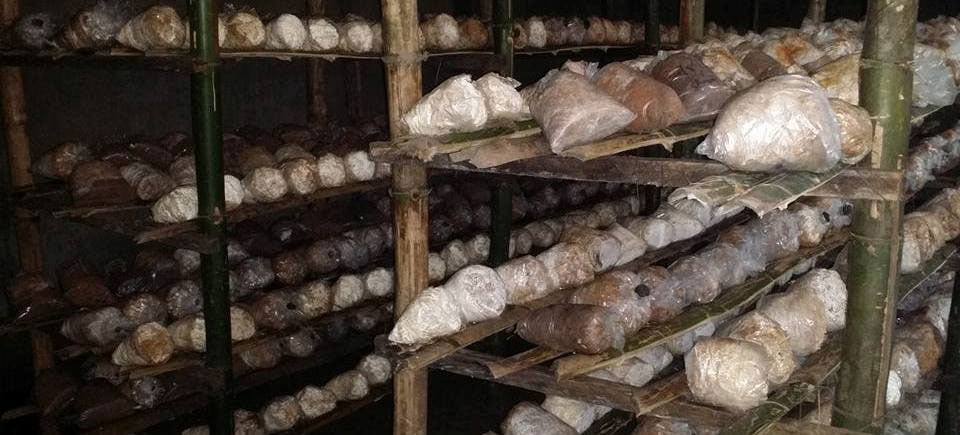
Mushroom Pinhead initiation starts after 10-12 days, and the mushroom crop is harvested in 50-60 days.
Harvest Mushrooms by light twisting without bothering the casing soil and When the harvesting is finished, fill the gap on beds with fresh, sterilized casing material and spray water.
The crop should be harvested before the gills are available because this might diminish its quality and market worth.
Mushroom Productivity
Generally, the longer method of composting 14-18 kg mushroom produce & 18 – 20 kg mushroom produced from the short method from 1000 kg compost.
Post-harvest management
Harvested mushrooms softly wash with 5g. KMS solution in ten litter water. After washing, remove excess water and pack these mushrooms in the polythene bag. the package practices depend upon the market & your customer demand
Economic of White Button Mushroom
here you get a basic idea about the economy of White Button Mushroom cultivation
| Particular | Details | Amount |
|---|---|---|
| fixed cost | ||
| Crop Room | size (30 x 17 x 9 ft) 3 tier | 25,000 |
| Spray pump | 1 unit | 1500 |
| Thermo-hygrometer | 1 unit | 500 |
| Bucket | 2 unit | 500 |
| weight Balance | 1 unit | 500 |
| Total | 28000 | |
| variable cost | ||
| Spawn, compost & casing soil | 10 ton Rs. 2000/- per ton | 20000 |
| Pesticides insecticides & formalin | 2000 | |
| Electricity, fuel, water charges | 1500 | |
| Polythene sheet | 2000 sq. ft. | 2000 |
| Miscellaneous | 1500 | |
| Total | 27000 | |
| Return | ||
| Total mushroom production | 1800 kg | |
| Market rate @ Rs. 60 per kg | 108000 | |
| Cost of Cultivation | 27000 | |
| Net Return | 81000 | |
Disclaimer: (The above calculations are indicative only.)

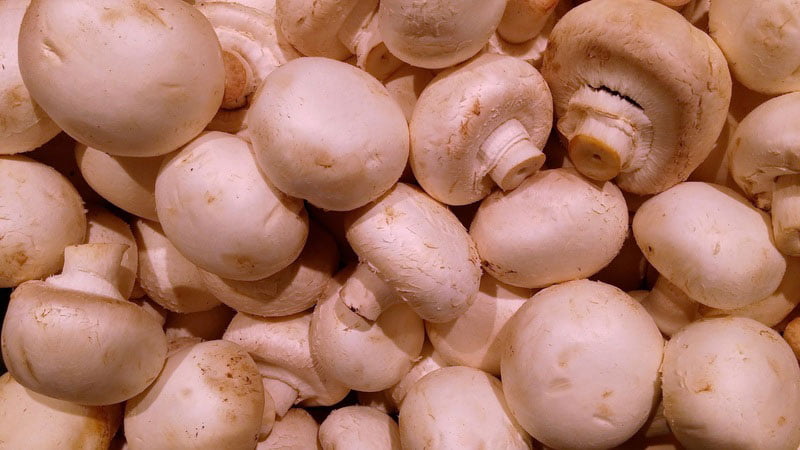


sir can you give me your contact no for farming
Hey anil
if you any query, please comment or post your question on a contact us page our team solves your query instantly.
Sir,
Can I have your contact no.Its for some business purpose .
Hello sir,
please contact 8788462787
नमस्कार सर मी प्रतीक इंगळे -हिंगणघाट वर्धा महाराष्ट्र ४४२३०७ येथे राहतो … सर्वतः मी तुमचे खूप खूप भर मानतो की तुम्ही शेतकऱ्याच्या प्रश्नांचे निवारण करण्यासाठी सज्ज आहात … मी गेली ६ वर्ष पासून भारतीय सैन्य दलात काम करतोय …सर आमचे गावाला ५ एकर शेत आहे …पण त्यामध्ये वार्षिक पिकांपासून फारसे उत्पन्न हाताला लागत नाही त्यामुळे मी एक ३०*६० फूट चे शेड बनऊन त्यामध्ये ऑयस्टर आणि बटण मशरूम यांची शेती करायचा विचार करतोय …मला या विषयात सखोल माहिती नाही youtube वरून मिळेली माहिती पुरेशी वाटत नसल्याने ..मला प्रत्यक्ष प्रशिक्षण केंद्राला भेट देऊन प्रशिक्षण घेणे आवश्यक वाटत आहे …जेणे करून मी एक लघू उद्योगाच्या दिशेने उचलले पाऊल प्रगतीचा मार्ग दाखवेल … सर मी जून २०२५ मध्ये सुट्ट्यांवर येणार असून मला महाराष्ट्रात जिथे कुठे या विषयी माहिती मिळेल त्या प्रशिक्षण केंद्राचा पत्ता कळवा ….तुमच्या प्रत्युत्तराच्या प्रतिक्षेत …प्रतीक इंगळे
Hello Sir,
please contact us at – 8788462787
Hi mate.
Happy to see your effort. Congrats
Could you tell me Button mushroom project is suitable for low cost investment like 5-10 lac. Rs.
Thanks, Bala
Sir
Can you give me your number
Hello Sachin
you can contact us via our email ID [email protected]
Hello Amar,
Tumbled upon your site while looking for agri based business. Nice to see people like you active in this space.
You have very nicely explained the basic economics of Mushroom Business. Thanks for that 🙂
I want to start a mushroom farm near Mumbai and needed information regarding training and buy back of the produce.
Request you suggest how should I take this forward.
Many Thanks
Thanks, Ajay
for training, details check on NRCM website
What about market sir,plz reply in hindi language
You can do marketing with own or with help of an agent. and another good news is we are launching agriculture guruji in the Hindi language soon.
Amazing work Amar,
I would be happy to know if I can use old factory unit (around 8000 Sq, Ft) for mushroom production. The Factory is empty and I have access to boring tube well for water requirements. I am electronic Engineer graduate and looking forward to setup my own business.. The factory is in out skirts of Mumbai , which have high demand for fresh as well as processed mushrooms.
Hey, Yash mushroom cultivation good option for you. i wanted to get the training you can contact us [email protected]
Be blessed for your entrepreneur spirit. I am also a Bio-technician in mushroom cultivation in Osire/Namibia. I would like to share with you about my experience and to know also how you deal with your challenges. thanks, Mbikay Sh.
Hello sir,
Thank you so much, you can contact me [email protected] or WhatsApp 8788462787
Hi it is possible lucknow uttar pradesh because it is not hilly area
yes of course
Hello buddy,
It was nice reading your blog, the content were amazing to be honest, I wonder how do you produce such a high quality valuable piece of well crafted content. I am really loving it. Keep up the awesome work and 1 more thing to add you’re content is charming to read and it makes me to read the content till the end. Worth sharing the link of this post ony my social pages aswell. Cheers to you
Thanks Sana
Hi Amar it is possible In Delhi because it is not hilly area.Pls Reply ASAP
Hello, Pankaj
yes you can start Commercial Mushroom Cultivation in Delhi
I am beginner in mushroom field. It’s possible should I start mushroom cultivation at Gujarat (Vadodara)?
Hi, Amit
yes, you can cultivate mushroom in Gujarat.
Thank you sir for sharing great piece of information.
Thank you, Ritesh
Hi Amit, Even I am interested in mushroom farming in vadodara. We can meet and learn more about it together. Do reply.
Sir, appreciate if U could make a similar post for Milky MUSHROOM in detail from Straw to post harvest.
Yes definitely, we publish a post on Milky Mushroom.
Hello sir, can get your mobile no.??
please contact us at 8788462787
Good information
thank you